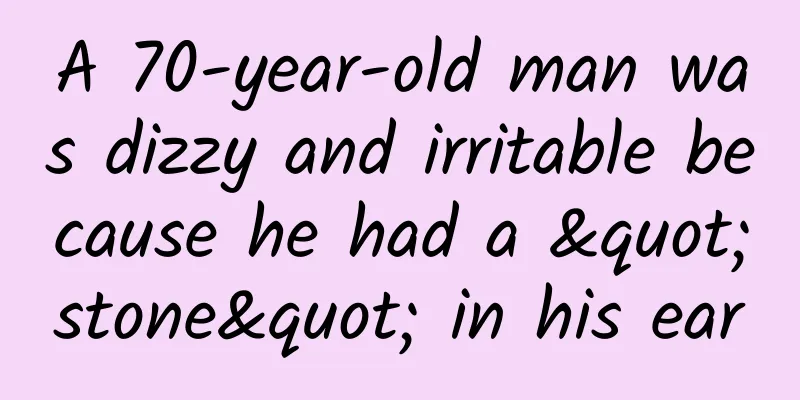A 70-year-old man was dizzy and irritable because he had a "stone" in his ear

|
Ms. Zhong, 75, felt dizzy when she got up, lay down, turned over, or turned her head. She came to the clinic of Professor Wu Dahua of the Department of Encephalopathy of the Affiliated Hospital of Hunan Institute of Traditional Chinese Medicine and was diagnosed with "otolithiasis". How can there be stones in the ears? Today, Professor Wu Dahua reminded that there are cystic plaques on the utricle and saccule of the inner ear, and there are many calcium carbonate crystals in the otolith membrane covering its surface. These are the "stones" in the ears, which can cause patients to feel strongly dizzy and lose balance. "Otolith disease" mostly affects middle-aged and elderly patients, but with the increasing number of people who are addicted to their phones, many young people also suffer from "Otolith disease". Recently, 75-year-old Ms. Zhong looked haggard, moved slowly, and had a stiff neck that she dared not move. She walked into the consulting room of Professor Wu Dahua of the Department of Encephalopathy of the Affiliated Hospital of Hunan Institute of Traditional Chinese Medicine like a robot. It turned out that in the past two months, the old man felt dizzy when he got up, lay down, turned over, turned his head, and had symptoms such as nausea, chest tightness, palpitations, irritability, etc. He took medicine and injections at the local hospital for half a month, but the symptoms became more and more serious. Professor Wu Dahua conducted a vertigo displacement test on the patient and confirmed that he had "otolithiasis". After repositioning treatment, the patient felt much more relaxed, the vertigo was significantly relieved, and he could move freely. After hearing that she had "otolithiasis", Ms. Zhong asked in confusion: How can there be stones in the ears? Professor Wu Dahua introduced that "otolithiasis" usually occurs in the deepest part of the human ear. There are cystic spots on the utricle and saccule of the inner ear. There are many calcium carbonate crystals in the otolith membrane covering its surface. These are the "stones" in our ears. These small otolith particles cannot be seen, touched or removed, and they fall into the semicircular canals (components of the inner ear). When the position of the head changes, the shaking stimulates the semicircular canals and produces an abnormal feeling of dizziness. Don't underestimate these fallen otoliths, which can not only cause patients to feel dizzy and lose balance, but also cause them to fall down instantly in severe cases. There are many factors that lead to the fall of otoliths, such as degeneration of the otolith membrane, metabolic abnormalities, trauma, inner ear ischemia, infection, etc. What are the main symptoms of "otolithiasis"? Professor Wu Dahua said that it can suddenly cause people to feel dizzy and nausea, vomiting and unstable standing. The disease has two characteristics: one is related to body position, often occurring when getting up, lying down, turning over, or turning the head; the other is that the dizziness is short-lived, lasting from a few seconds to tens of seconds. Medical data shows that "otolith disease" mostly affects middle-aged and elderly patients. Now, with the increase in the number of people who are addicted to their phones, working at desks for long periods of time, using mobile phones and computers with their heads down, frequently staying up late, having irregular work and rest schedules, and brain fatigue, many young people will also suffer from "otolith disease". Professor Wu Dahua reminds that after the onset of "otolithiasis", general drug efficacy is not ideal. The most effective treatment is to reposition the otoliths through the SRM-IV BPPV (otolithiasis) diagnosis and treatment system. After repositioning treatment, the patient felt much more relaxed, his vertigo was significantly relieved, and he was able to move freely. All pictures provided by the hospital When small otolith particles enter the semicircular canals, the position of the head changes, causing the semicircular canals to be stimulated and an abnormal feeling of dizziness will occur. |
<<: Why are there only humans on Earth? How many bird species are there on Earth?
Recommend
Can a mistake in insulin dosage be fatal? Scientific discussion of this scene in "The Long Season"
In the first episode of the hit suspense drama &q...
Symptoms of pregnancy during lactation
Generally speaking, pregnancy during breastfeedin...
What should I check at the hospital for irregular menstruation?
Generally speaking, when you go to the hospital f...
I'm so tired because I'm poisoned!!
Audit expert: Yin Tielun Unlike the energetic &qu...
If you keep losing hair, is there something wrong with your body? Here’s one tip to help you check yourself!
Hair loss has become one of the most common "...
What are the causes of black blood clots during menstruation?
The reason why there are black blood clots in men...
Not all women can take Wuji Baifeng Pills
For many women, the medicine Wu Ji Bai Feng Wan i...
The woman's nipples are black and big
Beautiful breasts not only need to be bigger than...
My nipples are so hard and painful to touch
Breast pain is very common in women, especially i...
Don't ignore vulvar itching and leucorrhea with odor, as the disease may be coming to you.
Leucorrhea is a barometer of women's health a...
Signs of a boy in early pregnancy
What are the signs of being pregnant with a boy? ...
No redness for the first time
Whether a girl bleeds for the first time is influ...
What is the cause of pain in the lower left side of the belly button?
Lower abdominal distension and pain caused by acu...
The dangers of wearing an IUD for a long time
There are many ways of contraception clinically. ...
Where is the mammary tissue in the breast
Women's breasts are one of the most important...









